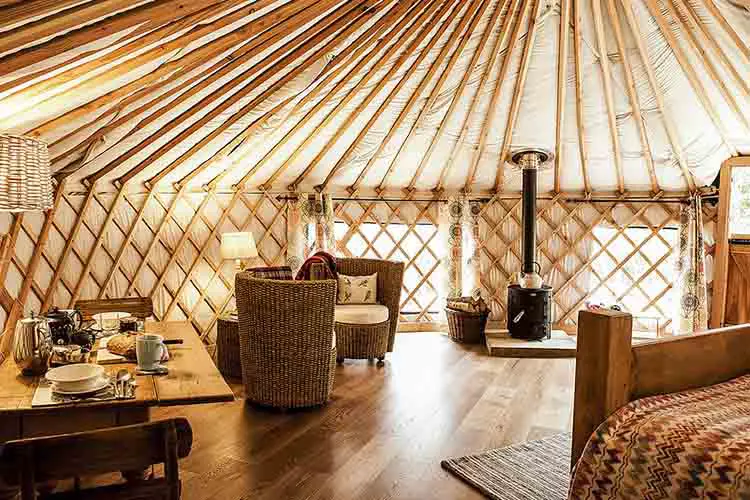Yurt living has become increasingly popular today but its history goes back thousands of years. The circular tent-like structures were originally used by nomadic people in Central Asia. Traditional yurts were made from a wooden frame woven into a lattice shape. The frame was separated for easy transportation and tied together with animal hair or rope.
They were relatively easy to take down and move to a new location – providing a good solution for a semi-permanent structure that still protected yurt dwellers from wind, rain, and snow.
Today, yurts are made with contemporary materials although wooden lattice walls, straight rafters, and tensions bands are still key features of its construction. Modern yurts have a central ring with an acrylic dome skylight and often include windows and plenty of natural light.
The simple design of a yurt still has wide appeal, their circular structure can be scaled to any size to accommodate your needs. The open-plan concept is still popular for its simplicity and minimalist style. But yurts can also be customized to include interior walls for modern bathrooms, kitchens, and privacy.
Yurt living is popular today for a number of reasons including:-
- They provide an environmentally conscious way to live (think: fewer resources to build and a smaller carbon footprint).
- Relatively easy, quick, and affordable to build using a yurt kit or build it yourself.
- Yurts bring you closer to nature and a simpler way of life.
- Yurt living is popular for adventurous types who enjoy the outdoors.
- Their simple design is appealing with its open plan living but they can also be customized with interior walls and separate spaces.
- They are bright and light with the traditional dome skylight and windows allowing plenty of natural light in.
- With the high cost of real estate, many are searching out alternative living situations including tiny houses, RV living, and yurts.
- In addition to being used as a primary residence, yurts have gained popularity for those looking to add living space to their property for their own use, for rental income on a property, or even commercial uses.
- They are popular for income-producing vacation homes or glamping resorts
- Yurts can also work well for a home office, yoga or meditation space, or an artist’s studio.
View this post on Instagram
With the increased popularity of yurt living, their simple design has evolved from the traditional one-room open plan layout. While the simplicity of the design is still appealing to many, others have enhanced the design by adding interior walls to include modern amenities such as bathrooms, kitchens, and private spaces for sleeping.
Yurt dwellers may even consider combining two yurts together to accommodate their living needs. Connecting two yurts provides a larger space or two separate spaces that can be used for different needs.
Why Connect Two Yurts
You might be considering connecting two yurts for many reasons including: –
- To maximize square footage
- It provides more space to accommodate a growing family
- To create living space for an aging parent or guests
- It improves the design of your yurt
- To produce rental income
- To create a separate space for a hobby or commercial use such as an artist’s or yoga studio
- It allows you to add a kitchen, a bathroom, or additional sleeping space
View this post on Instagram
How To Connect Two Yurts
There are a number of ways you can connect two yurts. The first consideration before you finalize your plan is to assess your family’s needs and lifestyle. For example, are you looking for the yurts to connect directly to each other with no space in between? Or do you want to add a hallway or breezeway in between the two to create a laundry room, mudroom, office, or other functional space?
Depending on your needs and how you want to design it, there are a few different ways you can connect two yurts.
Open Air -Some yurts are connected by a deck between the two yurts. This open-air concept is an easy way to connect two yurts. It might be an ideal solution if nicer climates but may not be a great idea if you get a lot of snow or rain and will get wet going between the two living spaces.
Hallway – Yurts can be located adjacent to each other and connected without a hallway. This is accomplished by securing the two-door frames to each other using short pieces of plywood. The
Breezeway – if you are building a breezeway, you can attach door awnings between yurts or use walls or plywood panels to enclose the breezeway.
Direct Connection – Two yurts can also be set adjacent to each other and connected without the hallway. This could be done by securing the two-door frames together with short sections of plywood and connecting the top covers together with additional fabric.

